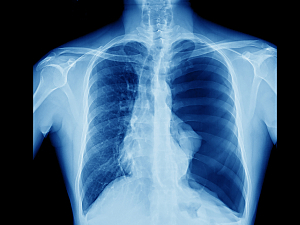Once the final chest drain is removed after cardiothoracic surgery, it is common practice to obtain a chest X-ray to evaluate for air or fluid that may have accumulated in the process of drain removal.
However, the results of a retrospective study at Brigham and Women’s Hospital suggest routine imaging isn’t necessary. Physicians from the Division of Thoracic Surgery at the Brigham, including Matthew M. Rochefort, MD, report the evidence in The Annals of Thoracic Surgery.
Methods
The researchers analyzed data on 200 adults who underwent minimally invasive wedge resection (59%), lobectomy (29%), or segmentectomy (12%) between March 2018 and September 2018.
Whether a chest tube or Blake drain was used was left to surgeon preference. All patients were monitored with serial chest X-rays, and chest drains were removed when clinically appropriate. A post-pull chest X-ray was routinely performed on all patients.
55 patients (28%) underwent a clamp trial at the discretion of the attending surgeon. Afterward, a repeat chest X-ray was obtained to ensure no large pneumothorax or subcutaneous emphysema had developed.
Incidence of Post-pull Pneumothorax
110 patients (55%) developed “post-pull” pneumothorax, but in 105 cases (96%), the pneumothoraces were classified as small, tiny, or trace. Four were mild to moderate in size and one was large.
In 101 patients (92%), the final chest X-ray showed pneumothorax, but only five patients had symptoms (two had pain and three developed subcutaneous emphysema). These pneumothoraces did not cause any hemodynamic or respiratory abnormalities, and no patient required an additional intervention because of them.
Factors Associated With Post-pull Pneumothorax
In univariable analysis, predictors of post-pull pneumothorax were:
- Segmentectomy (OR, 3.16 vs. wedge resection; P=0.023)
- Performance of a clamp trial (OR, 2.86; P=0.002)
- Recent resolved air leak (OR, 2.23; P=0.009)
Factors that protected against post-pull pneumothorax were the use of a Blake drain (OR, 0.35; P<0.001) and a Blake drain as the last drain removed (OR, 0.37 vs. chest tube; P=0.001).
In multivariable analysis, only a clamp trial increased the odds of post-pull pneumothorax (OR, 2.48; P=0.024). Blake drain, as the last drain was removed remained protective (OR, 0.46; P=0.018).
Guidance for Surgeons
Routine post-pull chest X-rays are useful for identifying pneumothorax, but they may not contribute enough to patient management to justify the additional radiation and cost. The results of this study suggest that post-pull chest X-rays could be reserved for patients with clinical signs and symptoms of pneumothorax and those at above-average risk, notably those who required a clamp trial or had a prior air leak.
